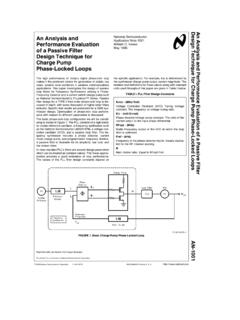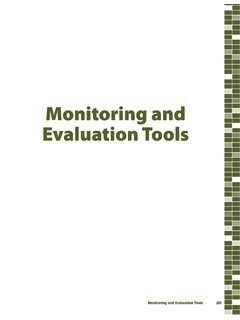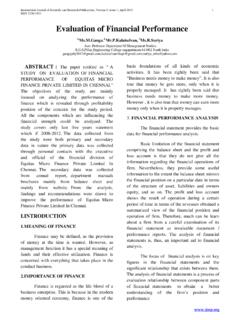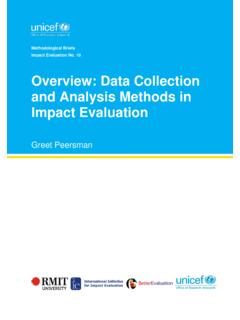Transcription of A quantitative assessment of student performance and ...
1 Journal of Instructional Pedagogies Volume 18 a quantitative assessment , Page 1 a quantitative assessment of student performance and examination format Christopher B. Davison Ball State University Gandzhina Dustova Ball State University ABSTRACT This research study describes the correlations between student performance and examination format in a higher education teaching and research institution. The researchers employed a quantitative , correlational methodology utilizing linear regression analysis . The data was obtained from undergraduate student test scores over a three-year time span. The purpose of this study was to investigate the predictive relationships between standardized examinations and practical examinations.
2 The data consists of 247 undergraduate students test scores spanning three academic years. Computer Technology students were assigned to take a standard midterm exam as well as a practical exam. The result of the analysis demonstrates that standardized examination scores are not predictors of practical examination scores and may well be testing different skill sets. Keywords: Standard exam, practical exam, test score, assessment , predictive modeling. Copyright statement: Authors retain the copyright to the manuscripts published in AABRI journals. Please see the AABRI Copyright Policy at Journal of Instructional Pedagogies Volume 18 a quantitative assessment , Page 2 INTRODUCTION This research study determined if any correlations exist between student performance and examination format in a large, Midwestern research/teaching institution.
3 The study data was derived from student examination performance scores. The data was collected from two technology-related courses over a three-year timeframe. In this quantitative , correlational study using regression analysis , a predictive model was created for each course. The research question proposed for this study is: are the standard examination scores a good predictor of the practical ( , hands-on) examination scores. Department of Technology faculty members noticed that there is a significant student performance differential between the standard examination and practical examination formats. Students who do well in the standard examination do not necessarily perform well in the practical examination. Resultant from this observation, the correlation and predictive modeling between the examination types were studied.
4 Purpose of the study The purpose of this is to examine the relationship between the standard examinations (typical True/False and multiple-choice questions) and practical examinations (hands on system administration tasks) for undergraduate students in a Midwestern computer technology program. The program is a part of the Department of Technology at a large research and teaching university. Research Question Are scores from standard examinations good predicators of performance on practical (hands on) examinations? To test this research question, data from two technology related courses were analyzed. The data was obtained from three years of test scores from a 200-level Systems Administration course and a 300-level Infrastructure Services course.
5 Hypothesis Null Hypothesis (H10): The midterm standard examination score does not significantly predict the midterm practical examination score for undergraduate students in a Midwestern computer technology program. Alternative Hypothesis (H1A): The midterm standard examination score does significantly predict the midterm practical examination score for undergraduate students in a Midwestern computer technology program. Both the Null and Alternative hypothesis were tested for two courses. The first course was a 200-level computer technology course focusing on systems administration. The second course was a 300-level computer technology course focusing on infrastructure services. Variables The independent variable selected for this study is midterm standard examination.
6 This variable was selected as a predictor for the dependent variable. The standard examination Journal of Instructional Pedagogies Volume 18 a quantitative assessment , Page 3 consists of a mix of 25 true or false and multiple-choice questions focused on MS Windows Server systems administration. Each question is worth 2 points for a total of 50 points. The majority of the test questions are derived from the textbook publisher s test-bank that is derived from the Microsoft 70-410 certification examination. The practical exam is a series of 8 MS Windows Server systems administration tasks. Each task is weighted between 10-20 points per successful outcome for an overall possible score of 100 points. The practical examination tasks are derived from the textbook material and closely related to the standard exam questions.
7 The context of all of the questions and systems administration tasks was the Microsoft certification examinations. Specifically, the Exam 70-410 Microsoft Official Academic Course for the System Admin Fundamentals (TCMP 211) Course and the Exam 70-412 Microsoft Official Academic Course for the Infrastructure Services (TCMP 311) Course. These courses prepare students for additional certification exams in their field of study for career enhancement. Additionally, these two courses are required for the Bachelor s Degree in Computer Technology. Environment and Control Both the practical exam and the standard exam take place in a classroom. The time limit for both examinations is 75 minutes. All students have finished both examinations within the time allotted.
8 No additional time was required or requested by the students in any testing phase over the course of the data collection period. The standardized exam is administered through the Blackboard system. Students open a web browser, login to the course room, and then take the examination. The Blackboard system scores the examination when the student submits it and immediately returns the score. The instructor administers the practical examination. All systems administration tasks are projected on a screen along with their concomitant point value (10-20 points per task). The students select the tasks and the order in which the tasks are attempted. The students provide screen shots of the tasks attempted or completed.
9 All of the tasks are performed on a pre-configured Windows Server 2012 virtual machine. Each student is provided a workstation with the working virtual machine installed on it. Both of the exams were administered in the same week at the same time of day. Both courses meet twice a week at the same time for 75 minutes. The standardized exam was administered on the first course meeting during Midterm week. The practical exam was administered two days later. Timeframe of Data Collection The data collection period was three years. The data was analyzed for correlations using SPSS software package. BACKGROUND LITERATURE Over the past two decades, there has been an upsurge of interest in how achievement goals influence self-regulated learning and academic performance (Covington, 2000).
10 There are number of existing studies pertaining to academic performance and factors that contribute to academic performance . Teacher engagement and student motivation are large areas of research Journal of Instructional Pedagogies Volume 18 a quantitative assessment , Page 4 in this domain (Zimmerman, Schmidt, Becker, Peterson, Nyland & Surdick, 2014).Additionally, there exists pedagogical research comparing standard examinations to practical examinations (Davison, 2015). However, there appears to be a gap in the research literature with regard to using standard examination scores as a predictor of practical examination scores. In this research article, this gap in the research literature is addressed by creating two predictive models (one per course) using standard examination scores as the independent variable and practical examination scores as the dependent variable.













